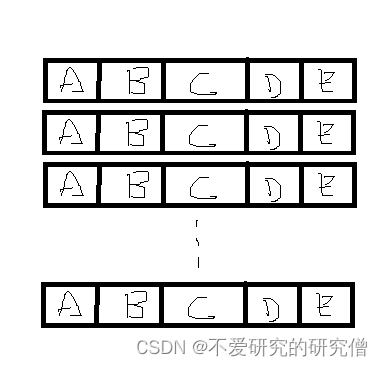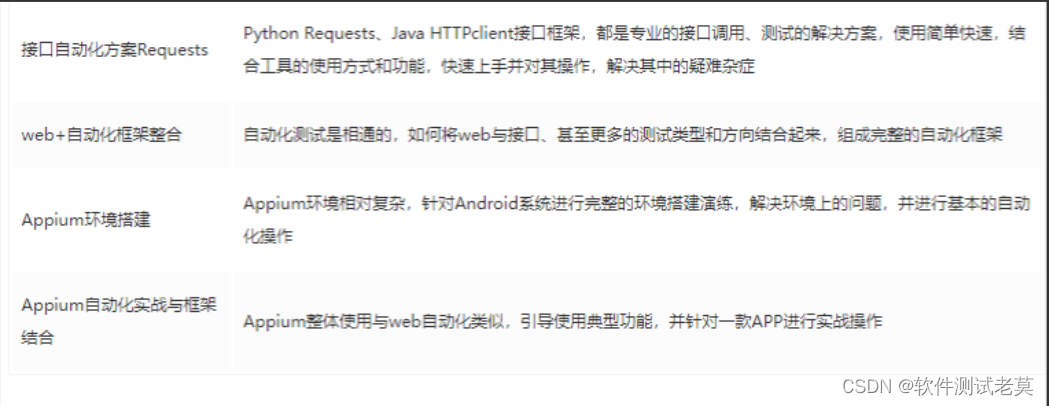当前位置:网站首页>LPP代码及其注释
LPP代码及其注释
2022-08-09 09:20:00 【qq_35774189】
function [eigvector, eigvalue] = LPP(W, options, data)
% LPP: Locality Preserving Projections
%
% [eigvector, eigvalue] = LPP(W, options, data)
%
% Input:
% data - Data matrix. Each row vector of fea is a data point.
% W - Affinity matrix(关联矩阵). You can either call "constructW"
% to construct the W, or construct it by yourself.
% options - Struct value in Matlab. The fields in options
% that can be set:
%
% Please see LGE.m for other options.
%
% Output:
% eigvector - Each column is an embedding function, for a new
% data point (row vector) x, y = x*eigvector
% will be the embedding result of x.
% eigvalue - The sorted eigvalue of LPP eigen-problem.
%
%
% Examples:
%
% fea = rand(50,70);
% options = [];
% options.Metric = 'Euclidean'; //欧氏距离定义: 欧氏距离( Euclidean distance)是一个通常采用的距离定义,它是在m维空间中两个点之间的真实距离。
% options.NeighborMode = 'KNN';//Put an edge between two nodes if and only if they are among the k nearst neighbors of each other. You are required to provide the parameter k in the options. [Default One]
% options.k = 5; //Default
% options.WeightMode = 'HeatKernel'; //Indicates how to assign weights for each edge in the
% graph.'HeatKernel' - If nodes i and j are connected, put weight
% W_ij = exp(-norm(x_i - x_j)/2t^2). You are
% required to provide the parameter t. [Default One]
%
%
% options.t = 5;
% W = constructW(fea,options);
% options.PCARatio = 0.99 //The percentage of principal component
% kept in the PCA step.The percentage is
% calculated based on the eigenvalue.
% [eigvector, eigvalue] = LPP(W, options, fea);
% Y = fea*eigvector;
%
%
% fea = rand(50,70);
% gnd = [ones(10,1);ones(15,1)*2;ones(10,1)*3;ones(15,1)*4]; //The parameter needed under 'Supervised'NeighborMode.
% Colunm vector of the label information for each data point.
% options = [];
% options.Metric = 'Euclidean';
% options.NeighborMode = 'Supervised'; //k > 0 Put an edge between
% two nodes if they belong to same class and they are among the k nearst neighbors of each other.
% options.gnd = gnd;
% options.bLDA = 1; //If 1, the graph will be constructed to
% make LPP exactly same as LDA. Default will be 0.
% W = constructW(fea,options);
% options.PCARatio = 1;
%
% [eigvector, eigvalue] = LPP(W, options, fea);
% Y = fea*eigvector;
%
%
% Note: After applying some simple algebra, the smallest eigenvalue problem:
% data^T*L*data = \lemda data^T*D*data
% is equivalent to the largest eigenvalue problem:
% data^T*W*data = \beta data^T*D*data
% where L=D-W; \lemda= 1 - \beta.
% Thus, the smallest eigenvalue problem can be transformed to a largest
% eigenvalue problem. Such tricks are adopted in this code for the
% consideration of calculation precision of Matlab.
%
%
% See also constructW, LGE
if (~exist('options','var')) %不存在返回1,存在返回0
options = [];
end
[nSmp,nFea] = size(data); %返回data的行数和列数,分别保存在nSmp和nFea中
if size(W,1) ~= nSmp %size()返回矩阵的行数
error('W and data mismatch!');
end
%==========================
% If data is too large, the following centering codes can be commented
% options.keepMean = 1;
%==========================
if isfield(options,'keepMean') && options.keepMean; %isfield()检查options是否包含由keepMean指定的域,判断输入是否是结构体数组的域。
else
if issparse(data)
data = full(data); %把稀疏矩阵转换为全矩阵存储在data
end
sampleMean = mean(data);%data是一个向量,mean(A)返回A中元素的平均值,如果是一个矩阵,mean(A)将其中的各列视为向量,求其平均值。
data = (data - repmat(sampleMean,nSmp,1)); %repmat()是对sampleMean矩阵进行指定的行数nSmp和列数1的复制。
end
%==========================
D = full(sum(W,2)); %sum(W,2)对W的行求和 %*D变成50行1列
if ~isfield(options,'Regu') || ~options.Regu
DToPowerHalf = D.^.5; %*DToPowerHalf为50行1列
D_mhalf = DToPowerHalf.^-1; %*D_mhalf为50行1列
if nSmp < 5000 %nSmp行数
tmpD_mhalf = repmat(D_mhalf,1,nSmp); %*将D_mhalf放大到50列,此时tmpD_mhalf是50*50
W = (tmpD_mhalf.*W).*tmpD_mhalf';
clear tmpD_mhalf;
else
[i_idx,j_idx,v_idx] = find(W); %找出i_idx非0元素所在的行,j_idx非0元素所在的列,v_idx非0元素的值。
v1_idx = zeros(size(v_idx)); %返回v_idx的行数和列数
for i=1:length(v_idx)
v1_idx(i) = v_idx(i)*D_mhalf(i_idx(i))*D_mhalf(j_idx(i));
end
W = sparse(i_idx,j_idx,v1_idx); %转化为稀疏矩阵,把0全去掉
clear i_idx j_idx v_idx v1_idx
end
W = max(W,W');
data = repmat(DToPowerHalf,1,nFea).*data;
[eigvector, eigvalue] = LGE(W, [], options, data);
else
options.ReguAlpha = options.ReguAlpha*sum(D)/length(D);
D = sparse(1:nSmp,1:nSmp,D,nSmp,nSmp); %由1:nSmp,1:nSmp,D组成的nSmp*nSmp的稀疏矩阵
[eigvector, eigvalue] = LGE(W, D, options, data);
end
eigIdx = find(eigvalue < 1e-3);
eigvalue (eigIdx) = [];
eigvector(:,eigIdx) = [];
% LPP: Locality Preserving Projections
%
% [eigvector, eigvalue] = LPP(W, options, data)
%
% Input:
% data - Data matrix. Each row vector of fea is a data point.
% W - Affinity matrix(关联矩阵). You can either call "constructW"
% to construct the W, or construct it by yourself.
% options - Struct value in Matlab. The fields in options
% that can be set:
%
% Please see LGE.m for other options.
%
% Output:
% eigvector - Each column is an embedding function, for a new
% data point (row vector) x, y = x*eigvector
% will be the embedding result of x.
% eigvalue - The sorted eigvalue of LPP eigen-problem.
%
%
% Examples:
%
% fea = rand(50,70);
% options = [];
% options.Metric = 'Euclidean'; //欧氏距离定义: 欧氏距离( Euclidean distance)是一个通常采用的距离定义,它是在m维空间中两个点之间的真实距离。
% options.NeighborMode = 'KNN';//Put an edge between two nodes if and only if they are among the k nearst neighbors of each other. You are required to provide the parameter k in the options. [Default One]
% options.k = 5; //Default
% options.WeightMode = 'HeatKernel'; //Indicates how to assign weights for each edge in the
% graph.'HeatKernel' - If nodes i and j are connected, put weight
% W_ij = exp(-norm(x_i - x_j)/2t^2). You are
% required to provide the parameter t. [Default One]
%
%
% options.t = 5;
% W = constructW(fea,options);
% options.PCARatio = 0.99 //The percentage of principal component
% kept in the PCA step.The percentage is
% calculated based on the eigenvalue.
% [eigvector, eigvalue] = LPP(W, options, fea);
% Y = fea*eigvector;
%
%
% fea = rand(50,70);
% gnd = [ones(10,1);ones(15,1)*2;ones(10,1)*3;ones(15,1)*4]; //The parameter needed under 'Supervised'NeighborMode.
% Colunm vector of the label information for each data point.
% options = [];
% options.Metric = 'Euclidean';
% options.NeighborMode = 'Supervised'; //k > 0 Put an edge between
% two nodes if they belong to same class and they are among the k nearst neighbors of each other.
% options.gnd = gnd;
% options.bLDA = 1; //If 1, the graph will be constructed to
% make LPP exactly same as LDA. Default will be 0.
% W = constructW(fea,options);
% options.PCARatio = 1;
%
% [eigvector, eigvalue] = LPP(W, options, fea);
% Y = fea*eigvector;
%
%
% Note: After applying some simple algebra, the smallest eigenvalue problem:
% data^T*L*data = \lemda data^T*D*data
% is equivalent to the largest eigenvalue problem:
% data^T*W*data = \beta data^T*D*data
% where L=D-W; \lemda= 1 - \beta.
% Thus, the smallest eigenvalue problem can be transformed to a largest
% eigenvalue problem. Such tricks are adopted in this code for the
% consideration of calculation precision of Matlab.
%
%
% See also constructW, LGE
if (~exist('options','var')) %不存在返回1,存在返回0
options = [];
end
[nSmp,nFea] = size(data); %返回data的行数和列数,分别保存在nSmp和nFea中
if size(W,1) ~= nSmp %size()返回矩阵的行数
error('W and data mismatch!');
end
%==========================
% If data is too large, the following centering codes can be commented
% options.keepMean = 1;
%==========================
if isfield(options,'keepMean') && options.keepMean; %isfield()检查options是否包含由keepMean指定的域,判断输入是否是结构体数组的域。
else
if issparse(data)
data = full(data); %把稀疏矩阵转换为全矩阵存储在data
end
sampleMean = mean(data);%data是一个向量,mean(A)返回A中元素的平均值,如果是一个矩阵,mean(A)将其中的各列视为向量,求其平均值。
data = (data - repmat(sampleMean,nSmp,1)); %repmat()是对sampleMean矩阵进行指定的行数nSmp和列数1的复制。
end
%==========================
D = full(sum(W,2)); %sum(W,2)对W的行求和 %*D变成50行1列
if ~isfield(options,'Regu') || ~options.Regu
DToPowerHalf = D.^.5; %*DToPowerHalf为50行1列
D_mhalf = DToPowerHalf.^-1; %*D_mhalf为50行1列
if nSmp < 5000 %nSmp行数
tmpD_mhalf = repmat(D_mhalf,1,nSmp); %*将D_mhalf放大到50列,此时tmpD_mhalf是50*50
W = (tmpD_mhalf.*W).*tmpD_mhalf';
clear tmpD_mhalf;
else
[i_idx,j_idx,v_idx] = find(W); %找出i_idx非0元素所在的行,j_idx非0元素所在的列,v_idx非0元素的值。
v1_idx = zeros(size(v_idx)); %返回v_idx的行数和列数
for i=1:length(v_idx)
v1_idx(i) = v_idx(i)*D_mhalf(i_idx(i))*D_mhalf(j_idx(i));
end
W = sparse(i_idx,j_idx,v1_idx); %转化为稀疏矩阵,把0全去掉
clear i_idx j_idx v_idx v1_idx
end
W = max(W,W');
data = repmat(DToPowerHalf,1,nFea).*data;
[eigvector, eigvalue] = LGE(W, [], options, data);
else
options.ReguAlpha = options.ReguAlpha*sum(D)/length(D);
D = sparse(1:nSmp,1:nSmp,D,nSmp,nSmp); %由1:nSmp,1:nSmp,D组成的nSmp*nSmp的稀疏矩阵
[eigvector, eigvalue] = LGE(W, D, options, data);
end
eigIdx = find(eigvalue < 1e-3);
eigvalue (eigIdx) = [];
eigvector(:,eigIdx) = [];
边栏推荐
猜你喜欢
随机推荐
MySQL事件_单次事件_定时循环事件
MySQL索引
网络安全入门基础:IP地址
TypeScript简记(一)
接口性能测试方案设计方法有哪些?要怎么去写?
本体开发日记01-Jena配置环境变量
手机APP测试流程规范和方法你知道多少?
【百日行动】炎炎夏日安全不松懈 消防培训“加满”安全知识“油”
div模拟textarea文本框,输入文字高度自适应,且实现字数统计和限制
学习双向链表的心得与总结
Global 19 Google Satellite Map Free View Download
map去重代码实现
The div simulates the textarea text box, the height of the input text is adaptive, and the word count and limit are implemented
jfinal加载配置文件原理
Teach you how to get a 0.1-meter high-precision satellite map for free
on duplicate key update
国产谷歌地球同款软件,查看下载19级高清卫星影像so easy!
on duplicate key update
测试计划包括哪些内容?目的和意义是什么?
秒拍app分析








